#cool bug fact's
Text
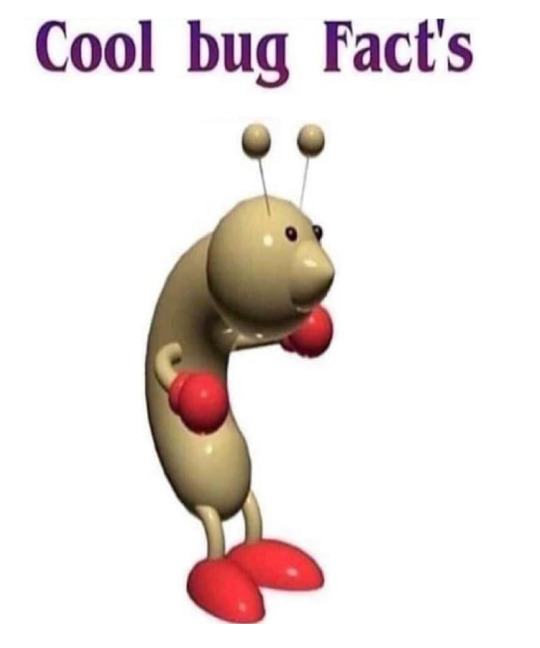
✨cool bug facts's✨
The creatonotos gangis!
TW: These are literally moths with tentacles
Imagine chilling in Australia, watching some moths, and some hot moth babes fly into your area and one of the moths you're watching sprouts tentacles.

The anatomy of these oddly affrighting Insects!!!
You see those tentacles? those are actually their coremata (also called hair-pencils), which on most male lepidoptera are straight, stick-like appendages of which they only have one of. Except for these guys for some reason. They're special and have four wriggly corematas (or whatever the plural is). The coremata is used to secrete pheromones, pyrrolizidine alkaloid, specifically, in order to attract a mate.
Do the hairs on their tentacles count as pubic hair???
They have a wingspan of 4 cm (1.5 inches).
While their abdomen is usually red, they may occasionally have a yellow abdomen.
Their larvae are brown and very hairy, with a yellow stripe along their back.
Like every other part of their body in both larval and adult stages, their cocoons are very hairy.
The females abdomen isn't as large or inflated as the males.
Diet.
The larvae eat groundnuts, rice, finger millets, sorghum, pearl millets, coffee, sweet potatoes, pomegranates, and alfalfa. These are all plants that have pyrrolizidine alkaloid in them. This is how they're able to release their pheromones. Meaning that if they don't eat enough as a larva, their coremata won't even grow to a size large enough to secrete pheromones.
While the adults don't eat very often, they do occasionally drink the sap from their host plants. Especially if they didn't eat enough as a larvae.
Behavior.
The pheromone that the males produce can only attract female moths, whereas male moths find it repulsive and will try to fly away from it.
If a female is attracted by the males pheromones, they will wiggle their abdomen at them, signaling that they want to mate.
(Plant behavior)
When they eat enough of a host plant, but not enough to kill it, the plant will release a poisonous amount of pyrrolizidine alkaloid, which tends to kill any farm animals that eat these plants.
Habitat.
Unsurprisingly, they are found in Australia. And Southeastern Asia, which also has some bizarre insects in it, but doesn't quite have the same reputation as Australia. They can also be found in Japan, China, and Papua new guinea.
The larvae are born on and live on their host plants.
The adults tend to hang around their host plants in case they ever need any food.
Cool fact that didn't fit here.
While trying to study their coremata due to it's abnormal shape, scientists realized the difficulty in trying to study coremata, and invented a machine to inflate the coremata on dead specimens. and they called it the Phalloblaster 😭😭.
#bugs#insects#moths#moth#creatonotos gangis#bugblr#entomology#lepidopterology#cool bugs#cool bug facts#cool bug's#cool bug fact's
166 notes
·
View notes
Photo

#peter president#a political cartoon (1974)#brick attempts to be funny#cool bug fact's#memes#peter u dumbass
10 notes
·
View notes
Text
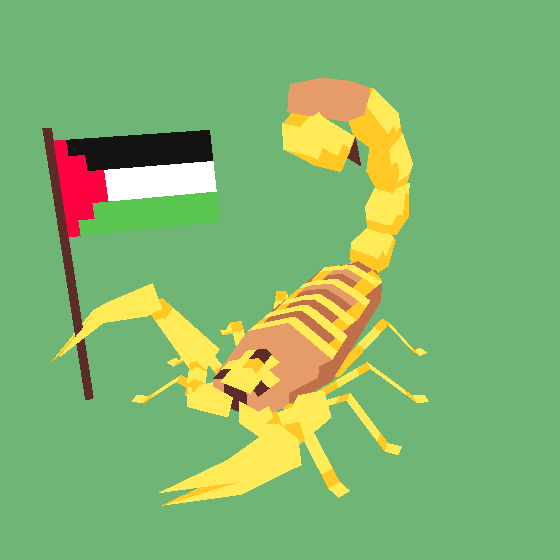
did you know? the deathstalker scorpion is also known as the Palestine yellow scorpion, and is widespread throughout occupied Palestine!
want me to model a creature of your choice in 3D, or see how i make things like this? i'll be streaming requests in exchange for donations as part of Drawings for Gaza! we'll be live at the following times:
Monday, Feb 19th at 10PM EST
Friday, Feb 23rd at 2PM EST
Sunday, Feb 25th at 6PM EST
the genocide in Gaza is getting worse every day, and no resistance is too small. educate yourself; call your local representatives; buy eSIMs so people can stay connected; donate to Operation Olive Branch, UNRWA, or PCRF; don't look away, and don't stay silent!
#free palestine#palestine#scorpion#deathstalker#3d art#lures you in with cool bug facts. go help people#gif#bugs#scorpions
9K notes
·
View notes
Text
#cool facts#facts#cool bug facts#interesting facts#amazing facts#cool bug fact's#fun facts#cool facts about space#cool facts bright side#cool bug facts meme#facts of life#animal facts#human body facts#geo facts#weird facts#fact#strange facts#cool bug facts god may not be so merciful#scientific facts#geography facts#small facts#facts about animals#facts you didn't know#psychological facts#historical facts#fun country facts#dailyfacts#factsdaily#psychologyfacts#factsaboutdailylife
0 notes
Text

I wonder if she’s out there
#I want to meet non-bug Jane Prentiss#bug wife#cool bug facts#tma#the magnus archives#tmagp#the magnus protocol#jane prentiss#the corruption#horror#podcast#rusty quill#art#fanart#meme
2K notes
·
View notes
Text
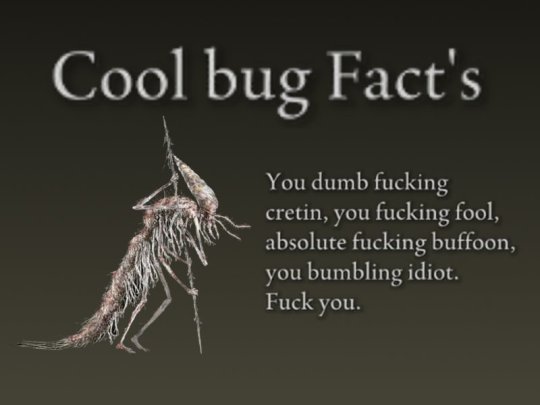
4K notes
·
View notes
Text
At a glance, you might think you can easily distinguish a butterfly from a moth. But take a closer look. There are colorful moths and day-flying moths that can throw you for a loop! Next time you come across a member of the Order Lepidoptera, use these tips from Insectarium host Dr. Jessica L Ware.
Learn more about butterflies in Insectarium on the PBS Terra YouTube channel.
#science#amnh#nature#natural history#animals#video#did you know#fun facts#butterflies#butterfly#moths#moth#lepidoptera#entomology#bugs#fact of the day#cool animals
593 notes
·
View notes
Text
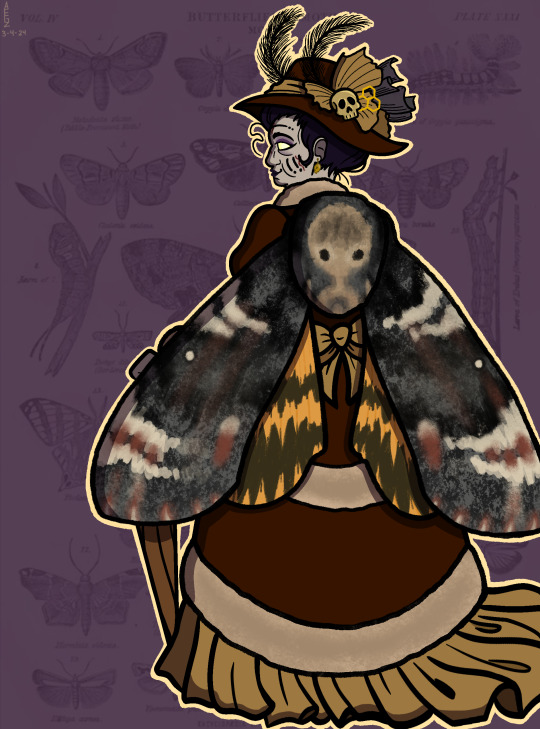
I think a death's-head moth is way more fitting for her than a stinkbug but maybe that would've been too on the nose
#also cool bug fact’s: deaths head moths are known to infiltrate beehives by mimicking the scent of bees in order to eat honey#so the stinky sigil on grimora’s card would still fit#no disrespect to stinkbugs but i feel like she could’ve had a better bug assignment#my art#grimora#inscryption
280 notes
·
View notes
Text
“Sebastian doesn’t have any character development!” “Sebastian hates Ciel, he’s just his meal!” "He doesn't care - "
Yeah ok then explain this:
Chapter 4

Chapter 114





#chapter 4 sebastian: it's cool as long as he isn't dead lol get wrecked bug#one hundred and ten chapters later#sebastian: if anyone so much as breathes on the young master i will commit war crimes#this isn't even seeing things with shipping glasses on it's just straight up facts#sebastian michaelis#black butler#kuroshitsuji
268 notes
·
View notes
Text
Let's learn ANTatomy!
The lower portion of the antennae is called the funiculus. (in other parts of biology a funiculus is a bundle of nerve fibers, and this is the most sensitive part of the ant, so it makes sense... also what could be more FUN that tapping everything with your antennae?)

The base of the antenae is called the scape.
The coxa is the joint that connects her ant legs to her mesonoma, aka thorax.

Ant feet don't have toenails, they have tarsal claws.


#ant fact#ant words#ant vocabulary#vocabulary#cool words#ants#ant keeping#harpegnathos saltator#myrmecology#antposting#bugblr#insects#invertebrates#ant#antblr#antkeeping#bugs
119 notes
·
View notes
Text

✨cool bug facts's✨
Trachelophorus giraffa, or the giraffe weevil!
Aughdhgh the neck

The anatomy of these Achates-shaped insects!!!
The males necks are typically 2-3 times the length of a females, but can be much larger, as they are one of the most diverse species of weevils when it comes to height.
Their whole body and wings are black, but their elytra are are an ostentatious red.
The males are around 2.5 centimeters long, which is nearly the longest any attelabid species is.
The larger males snouts and legs' tissue aren't as metabolically active as the smaller males. The larger males also have more cuticle, meaning that despite their ridiculously large size, they use up less energy than the smaller males.
The larger males can be 30 times the size of the smaller males.
Smaller males typically die younger than larger males.
The females have very powerful legs compared to the males.
They are a species in the attelabid family, which is one of the few families of primitive weevils.
Diet.
The larvae eat the nests they were born on.
The adults eat the leaves from the Dichaetanthera arborea, unscientifically known as the giraffe beetle tree, because that's really all this tree has going for it.
Behavior.
The males use their necks to joust with other males, similar to how other beetle species use their horns and mandibles. But instead of trying to pick up and throw their opponents, they try to shove them off their tree.
When startled, they will backflip off their tree.
In order to actually be able to mate, the smaller males will sneak under the larger males while they're mating.
If a female prefers a specific male who's fighting over them, they will walk in between the fighting males, breaking up the fight. They will then shoo away the male they don't like, and mate with the preferred male.
Even if they haven't mated yet, the females will make a nest for their eggs using their neck, by way of pressing their neck against the leaf to make indentures. After making these indentures, they use their legs to fold the leaf in half and curl up the edge of the leaf. When they do this, they only lay one egg in the curled end of the leaf and snip the leaf off their tree. They will then go do this to other leaves until they've laid all their eggs.
The males may try to help their mate make their nests, but they typically don't follow the normal procedure. This can lead to the female pushing their mate away after a while. The males may actually help by getting rid of smaller insects that could harm the eggs.
Habitat.
They live in Madagascar, but have a cousin species with the same name that live in New Zealand.
They spend their entire lives on a Dichaetanthera arborea. They are rarely seen not on their tree, except for when they're in the larval stage, as the larvae are born on the collapsed leaves from the Dichaetanthera arborea.
Cool fact that didn't fit here.
They were only discovered in 2008, which unfortunately means that not as much is known about them compared to other insects.
#bugs#insects#beetles#weevils#primitive weevil#belidae#giraffe weevil#trachelophorus giraffa#bugblr#entomology#coleopterology#cool bugs#cool bug facts#cool bug's#cool bug fact's
102 notes
·
View notes
Text

#what the fuck#milgram#ミルグラム#admin mercury#milgram muu#muu kusunoki#Cool bug fact's!#one day you will have to answer for your sins and god may not be so merciful#saturn is still going bonkers over backdraft tho its a little funny and a little sad#we had collective braincell and it said girl what the fuck
660 notes
·
View notes
Text

What does this mean? You decide!
#invader zim#iz#zim#dib membrane#zadr#fanart#comic#written drawn inked colored and lettered by a moron#wrote this dialogue at probably 4:00 am#my art#look look look i think female irkens have longer antennae because (they're all curly n' stuff) COOL BUG FACTS#they tried to put my cool bug facts on the cover of vogue but my rant was toooooooooo loooooong
1K notes
·
View notes
Text
#facts#cool facts#fact#interesting facts#amazing facts#random facts#cool bug facts#cool bug fact's#fun facts#cool facts about space#cool facts bright side#cool bug facts meme#facts of life#animal facts#human body facts#geo facts#weird facts#strange facts#africa facts#cool bug facts god may not be so merciful#scientific facts#geography facts#its fact#fun fact#small facts#american countries facts#it's fact#fact bhai#shorts#interestingfacts
0 notes
Text
The Speculative Analysis About Irkens No One Asked For: Part II
Hiya! Back at it again with not shutting up about the lil green dudes. In case you found this first, here’s the Part One of this spiel, touching on some of the environmental theories about Irk and its cyberpunk-leaning cultural direction. While this post is dedicated to a more biological look of what’s going on with the Irkens, there was some leading context and other tidbits back in that one you may also enjoy, too.

So, carrying through what we previously set up, I want to… admit off the bat that, I found it a little difficult at first, you know?-To pick an angle I wanted to sink my teeth into. With how old the show’s become and how creative & enthusiastic a fanbase it attracted, it’s getting hard to really note (or theorize) something about Irken anatomy that hasn’t been said before somewhere. And don’t get me wrong, that’s awesome and I love almost every word of it I’ve read. A lot of it from various sources is almost certainly going to bleed together into the first half of this. So, keep it in mind, yet I will try to chew a little deeper into the questions we can’t actually answer with just a rewatch of the show, all good? Because there’s a few more base things we know from the canon I’m going to include to start listing:
- Irkens lack any visible form of nose or ears, but are equipped with a pair of sensory antennae. Presumably, these organs fulfill the same roles, as they do in real-world insects.
- Irken organs are obviously very alien, not well explained, artificially enhanced, and hard to compare to that of a human’s- outside of their general body shape, the presence of a primary brain separate from the PAK, and the fact that they do possess something of an internal skeleton.
- A petite race on average (relative to humans), Irkens universally follow an unquestioned social hierarchy based on individual height.
- Irkens are endowed with a remarkable ability to regenerate and heal superficial injuries, even up to repairing the damage of being nearly skinned alive (chest-down) or severely burning their corneas within a matter of hours.
- Their preferred diet is one that is rich in (if not primarily made of) refined carbohydrates, and while they seem to tolerate fatty sources, such as processed dairy, their anatomy is poorly suited for dealing with high-protein foods like beans and meat.
- In fact, all forms of contact with exposed animal meat itself will cause it to dissolve and meld into their own flesh, via an incredibly painful process.
- On contact with water from Earth, their skin will receive harsh chemical burns (This has been explained by Vasquez to be a consequence of impurities and man-made pollutants, which Irkens seem sensitive to).
- While I’m already on a roll about their skin, it also contains/produces a substance capable of killing lice.
Now, I think we’ve all heard a lot about sqeedily spooches, but does anyone else want to keep marinating a second longer on the topic of s k i n ? Because I have some damn thoughts to release about Zim’s outer casing.
Let’s Get Chemical
First hot take, and the hill I am willing to be slain on: That ain’t actually skin! At least, it is nothing chemically alike to Earth-native vertebrate skin. I’ve given all of the above and the general running theme about Irkens resembling arthropods a lot of thought, and I’ve come to about the only conclusion I could that makes their dermis equivalent… make sense.
See, one of the biggest traits that sets apart invertebrates from other animals in real life is the “innie or outie” skeleton question, but you gotta understand that the “skeletons” that bugs and crabs have would still be considered something completely different from our endoskeletons even if they were on the inside. The hard tissues that make up OUR skeletal systems are mostly made up of a *collagen (remember that word!) frame that is reinforced by calcium, phosphorus, and other minerals. The hard parts of an ant’s skeleton, on the other foot, are mainly composited of chitin.
Chitin, now, is a very neat substance. It’s a polysaccharide, meaning that it’s made up of a bunch of sugar molecules chained together. This makes it distinct from proteins, which are made of amino acid chains instead of carbs. Chitin is also one of the single most important structural polymers in the universe to a ton of existing life. It makes up the literal backbone of arthropods and the cell walls of all fungi. We’ve even found it in fish scales and some amphibians. So, must also be important to humans, right? NAH. Not a chance. Higher animals actually long ditched the ability to synthesize the stuff, and are not any the worse for it, since there’s more than one way to stick a bunch of creature pieces together. For two examples, keratin and *collagen are proteins we naturally synthesize that functionally do the same thing. Keratin is the hard substance that makes up hair & fingernails, and collagen is practically the wonderglue of flesh: It’s a fundamental binder that holds together your bones, your skin, your precious muscle meats, the ligaments, the tendies, the nerves…
pretty much the whole person blueprint if you get the picture.
And thus concludes your (VERY overly simplified) highshcool bio class recap, but what the hell did that have to do with the cartoon spacemen again? I’m gonna round back to them through a funny secret about exoskeletons, actually: They have a softer part, too! Chitin’s hella diverse in its forms and utility. What’s in an exoskeleton is actually a version of it modified with other materials (like what’s done to collagen in bone) to make it so rigid and shell-like. A purer chitin, on the other hand, is more leathery and flexible, less like the shell of a beetle and more like the squishy wall around a caterpillar or maggot. Even the hard bodied insects still have an endocuticle layer like this hiding just under the “shell”, still considered part of the whole exoskeleton, but suddenly looking and acting more like we’d call a skin.


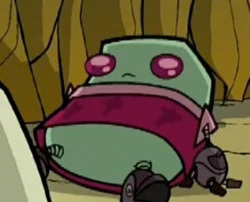
Eh, see where I’m going with this? My conviction is this- Irkens may have used to be even more arthropodal in an earlier stage of their evolution, including BOTH an internal skeleton, and some form of protective exoskeleton in their body plan. And hey, maybe the two were extensions of the same system once, too. You recognize something like that in modern tortoises when you remember that their “shells” are actually just the bone structure of their own ribcage. Then, let’s say that Irkens later saw the loss of their heavier exocuticle, leaving behind the endoskeleton and the flexible inner (now just an outer) cuticle of what used to be an entire body shell. This could have been a gradual change, via natural selection, or it could have been another artificial mutation brought on by technology- wherein the elder brains decided the feature was less efficient and simply phased it out of the cloning process- the same as the loss of their species’ sexual organs.
But, you’re thinking, why on Irk would the loss of an entire badass armor layer be beneficial to their fitness? Few reasons- For one, they are cumbersome and limiting. The downgrade on freedom of movement and flexibility they would be for a bipedal humanoid is self-explanatory enough. When it came to structural integrity, the inner skeleton would have already done a well job with little modification. For all the protection they provide, they don’t leave much room for expansion, and need to be shed in order for the animal to grow any further or to recover from certain injuries. The process of molting itself would be an excruciating process for any intelligent species to have to endure; one that also temporarily leaves the critter in a very vulnerable and stressed state for every molt. To advance from more primitive origins into a dominant race, manual dexterity and mobility would have to take a front seat over a small amount of modest defenses, and mind you, Irk long ago woulda managed to compensate for that loss in the form of advanced weaponry (obviously).
I’m also of the mind that the shift away from an exoskeleton could have even been the key to allowing the Irkens to even grow to the size they are now. Recall back to Part One for a second, where I shared the likely case for Irk having a massive bulk behind its gravity field. Gravity is a hard thing on any skeletal structure, representing a constant strain to be fought against when moving, growing, and bearing weight .There’s a lot of factors behind why we don’t have horse sized spiders or elephant sized lobsters IRL, and weight is actually one of them. Notice how terrestrial isopods only get about to the size of a bean, but the aquatic ones can top out at over a foot long? And that’s only having Earth’s level of gravity to struggle against, let alone however harsh the conditions would be on a larger planet.
So, there’s my framework for explaining what I think the aliens’ cuticle is not; however, what does that mean for what it is, besides “feels and looks like a grub’s”?
Well, look again at some of the extraordinary things it can do.
Cooties Immunity
“Germs” was a memorable episode that posed a very legitimate question to the viewer. Why IS IT that foreign pathogens aren’t a bigger concern for the invaders? They’re literally sent off to other worlds to blend in: Socializing with the native inhabitants, eating their foods, and living in an alien habitat. In the case of an undiscovered rock like Earth, our infectious diseases would have no reference available to the Armada whatsoever. Sure, species incompatibility would provide some protection, but the risk of something carrying over and adapting is always still there. Zoonoptic jumps happen all the time with bacteria and viruses, and Zim’s body temperature IS in the normal human range. And what about fungal pathogens, or parasites-
Oh, wait, the lice episode gave it away right there.

I love this sequence so much, because it’s coincidentally like, an exact “art imitates life” parallel to something a real species of primate does. Black lemurs live in the same area of Madagascar as these vibrant, red millipedes.
The millipedes are special because when threatened, they secrete a poisonous substance from their skin. The lemurs are special because they like to grab the bugs and nibble them for no other reason than to make them release those toxins. Those chemicals are then rubbed into their fur, because somehow the lemurs figured out it makes a really handy mosquito repellant. The lemurs also like to get completely zonked out on the chemicals too but eyy- Point was it stands to reason that Irkens may also secrete small amounts of their own potent toxin from the cuticle, perhaps for more hygienic than defensive purposes. This secretion would be responsible for protecting them from parasites and topical infections. Could it also make people blazed out of their minds? …Maybe? I think I’d like to promote the “Just Say No” policy on the matter of licking aliens, though. Ffs at least ask them out to dinner first.
When it comes to other kinds of sick, looks like it might be the trusty old PAK to the rescue here again. I imagine that, being an intergalactic, partially mechanical civilization, the Irken race has come down this road enough to put in a workaround. A standard PAK contains the entirety of the population’s collective knowledge/history- which would include a catalog of all known infectious agents they have encountered across the universe. Some kind of nanobot-bolstered immune system that could detect and respond appropriately to new threats isn’t out of the question, nor should a feature that can automatically administer the appropriate medicine directly into the wearer’s bloodstream. For all this awesomeness, nonetheless, there remains a downside or two that they haven’t quite conquered..
The Meaty, Sweety, Mending of DOOM
Anyone ever actually think about how as far as resilience is concerned, Zim is practically an X-man compared to any Earthling? He has regenerative capabilities that surpass anything else on earth, save idk, bamboo shoots, if even. Injuries that would leave a human permanently disabled only seem to incapacitate an Irken for a few hours to a day at most. They’re all the more tough to put out of commission when considering that a PAK doubles as a form of backup life support, ready to “soft reboot” the host with a quick jolt if it detects a sudden drop in vital signs. It is tempting to credit the same device as the source of this healing boost as well, teasing the nanobot suggestion again; however, I see a chance instead to bring this back a step.
Although not as quick-acting as Zim, or Skoodge’s healing, there are some remarkable examples of regeneration in real arthropods, from repairing tissues/organs to replacing entire lost limbs. What the aliens are packing doesn’t seem all that different, only refined (through years of bioengineering) to work at a truly frightening efficiency. It shows through in their diet as well. Almost always, if we see a member of this species eating on screen, and believe me there was no shortage of examples, what are we watching them shovel their face with?
Space doughnuts, space popcorn, space Fun-Dip, sodas, and curly fries. Sure, there’s plenty of calories here, no doubt with the amount of carbs and grease that could even turn the stomach of a college freshman, but is this… nutrition?
Yes. Just not for us.
Like their civilization, we have also turned the mass production of sweet-packed, fat loaded foods into one of our favored art forms, and there are scattered pockets of our planet that can enjoy these items in cheap abundance. The catch 22? Obesity and heart disease. Meanwhile, Irkens are so metabolically blessed that they can follow the same lifestyle and actually be thriving by it. We know that the majority of human food is utterly toxic to Zim, but then there were waffles, a literal stack of dessert and butter that pretends to be a breakfast…. Our guy was experiencing the “finally some good fucking food” meme from the first bite off that plate, but this can’t seriously be healthy,or if it is, then how?
Well, if I did sell you on the idea that much of their tissues and skeleton swaps out a chitin base where we would be using protein, there you go. Sugars for the building blocks to synthesize the connective/structural tissues for maintaining the body, and the bulk of the energy required to keep it running.
And I won’t make the leap and suggest that’s all they have.
After all, the Irken equivalent of sandwiches do actually seem to contain “lettuce” and something that people will say looks like meat slices while not convincing me. I can get behind the thought of the natural or maybe original Irken diet to be a mix of plant matter and supplemental fungi, but everything I’ve put together implies that they are completely unfit for processing the goodies in animal flesh.
Overwhelmingly, I believe that the only time they possibly even seek out more sources of amino acids is going to be when they are smeets. That’s how it works in many wasp species. I.e. The growing larvae are the only ones that actually get to reap from the hard work of a colony hunting down enough protein to feed them with, yet the adults live out the rest of their lives more than content to gorge themselves on nectars and fruits exclusively!
And you even could put that aside, but you’ll have to grapple with the ungodly thing that happens every single time you see Zim touching a piece of meat. Would be awfully convenient to blame it on his personal brand of weirdness, or earth contaminants, but we remember this was a weakness that Tak approached fully aware of and expecting.
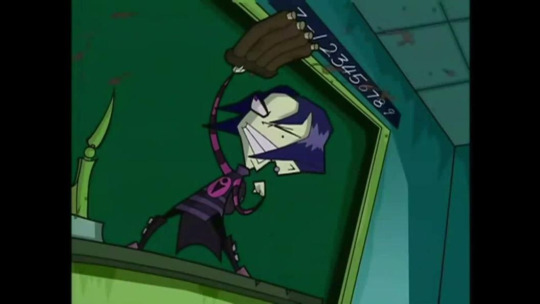
We know that polluted water can burn them. We know that beans and other foods can give them grotesque allergic reactions. Well what in the horrifying name of Resident Evil is this, though?
Buddy pals, I think we got some unintended consequences of that bio-hacking on hand. Collagen and chitin aren’t just functionally similar to each other, they are practically analogous building blocks.
For a WILD science fact, consider that there’s a ton of ongoing research into the application of chitin and chitin-derivatives into having a role in tissue engineering, as a hypothetical scaffold in lab cultured meat, and as an effective wound dressing ingredient.
What we’re seeing with incidents like Dib throwing that Bologna at Zim could be an extreme form of the vise versa, because I know a certain protein that processed meat happens to be pretty high in :)))
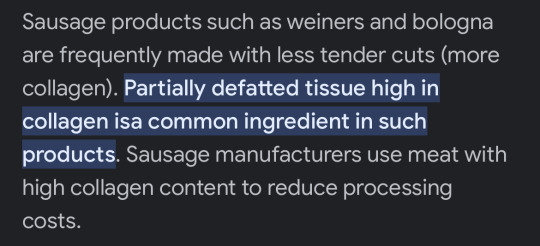
Imagine the coupling of this with the bioengineered genome of Zim’s kind being so… reactive to a foreign intrusion, yet also flexible to modification. Maybe it is the acids, or some contaminant/seasoning on the meat that first damages the cuticle. That healing ability kicks in, but doesn’t stop where chitin does, readily binding to and with the collagens in these strange tissues that are sorta like an Irken’s but also just enough not like an Irken’s that it also kicks the immune system into overdrive. Think of all the pain and inflammation of a poison ivy rash but if the damn plant itself could also fuse itself with whatever you brushed against it. I think Zim actually had an understandable reason to be homicidally pissed off for that Bologna assault. Also how the Bologna virus was accelerated in Zim’s body. Once it had incorporated itself into his own DNA, it was game set and match with the speed and help those cells had to replicate themselves.
And uh, yeah, I think this post has gotten about as long as it reasonably should be here. I did have a couple more points I really wanted to get out of my brain about the Almighty Tallest, and I think that would be a good launching point actually for a possible (and hopefully final jfc) part three to this. Till then I got some off-topic scoliids to taxidermy 👀
#invader zim#iz fandom#irkens#xenobiology#iz#scarlet talks about things#long post#we hyperfixating#absolute ramblings i mean holy crap#cool bug facts#sci fi
218 notes
·
View notes
Text

IM FREAKING OUT RN I LOVE HER SO MUCH THANK YOU @teethflavoured
114 notes
·
View notes